The Interplay of Culture and Organizational Strategy
VerifiedAdded on 2023/06/10
|7
|1544
|115
Essay
AI Summary
This essay delves into the significant relationship between organizational culture and strategic planning. It begins by highlighting the crucial role of culture in shaping a company's effectiveness and its impact on various aspects of the business. The essay introduces the Competing Values Framework (CVF) and discusses four distinct cultural types: clan, hierarchy, adhocracy, and market cultures, illustrating each with real-world examples. It then explores the debate surrounding which culture is most effective, emphasizing that the best approach depends on the specific needs and goals of the organization. The essay underscores that organizational culture, encompassing shared beliefs and values, forms the basis for strategy development and implementation. It argues that a strong alignment between culture and strategy is essential for achieving competitive advantages, fostering adaptability, and promoting efficient operations in the global marketplace. References from various academic sources are included to support the arguments presented.
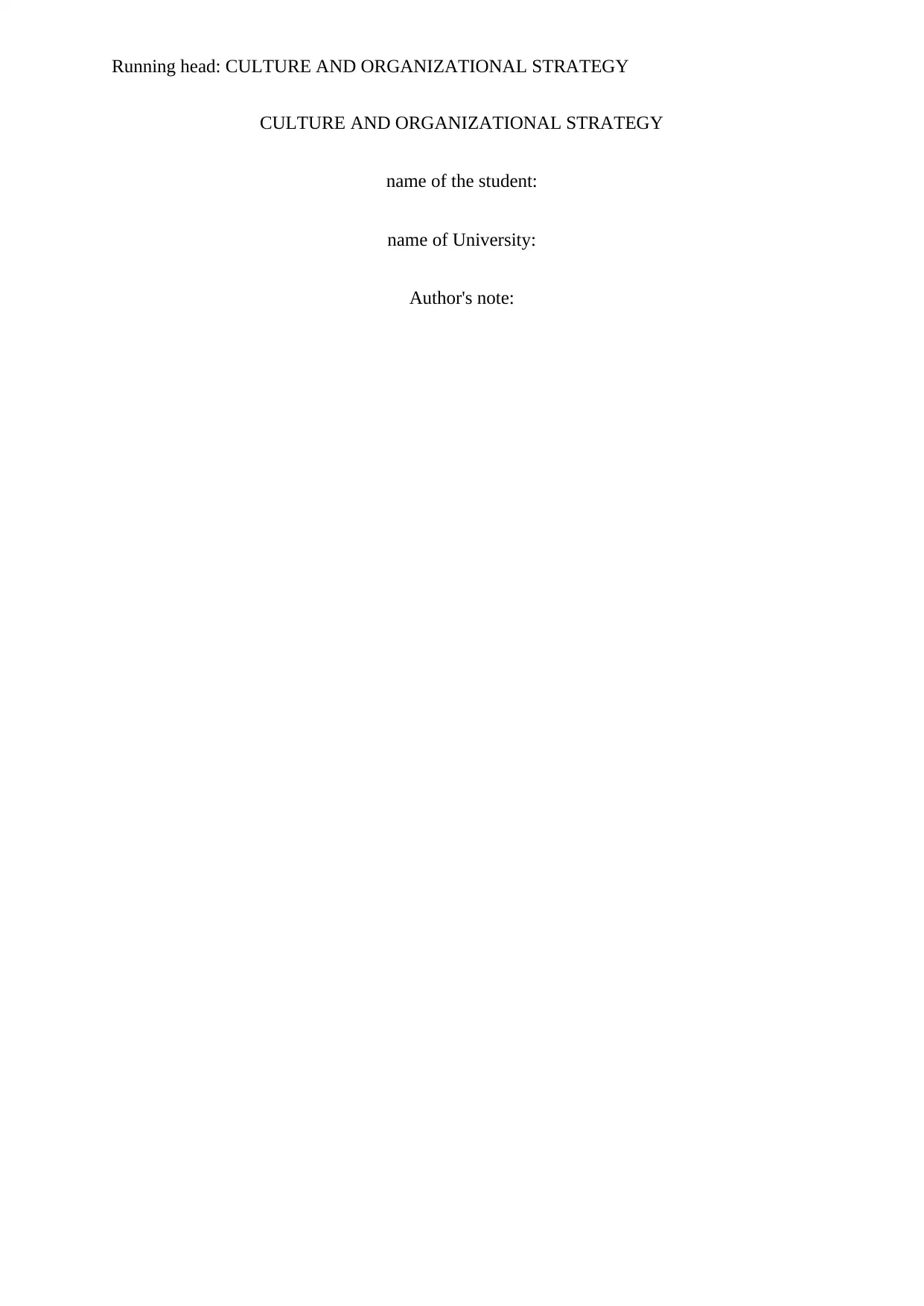
Running head: CULTURE AND ORGANIZATIONAL STRATEGY
CULTURE AND ORGANIZATIONAL STRATEGY
name of the student:
name of University:
Author's note:
CULTURE AND ORGANIZATIONAL STRATEGY
name of the student:
name of University:
Author's note:
Paraphrase This Document
Need a fresh take? Get an instant paraphrase of this document with our AI Paraphraser
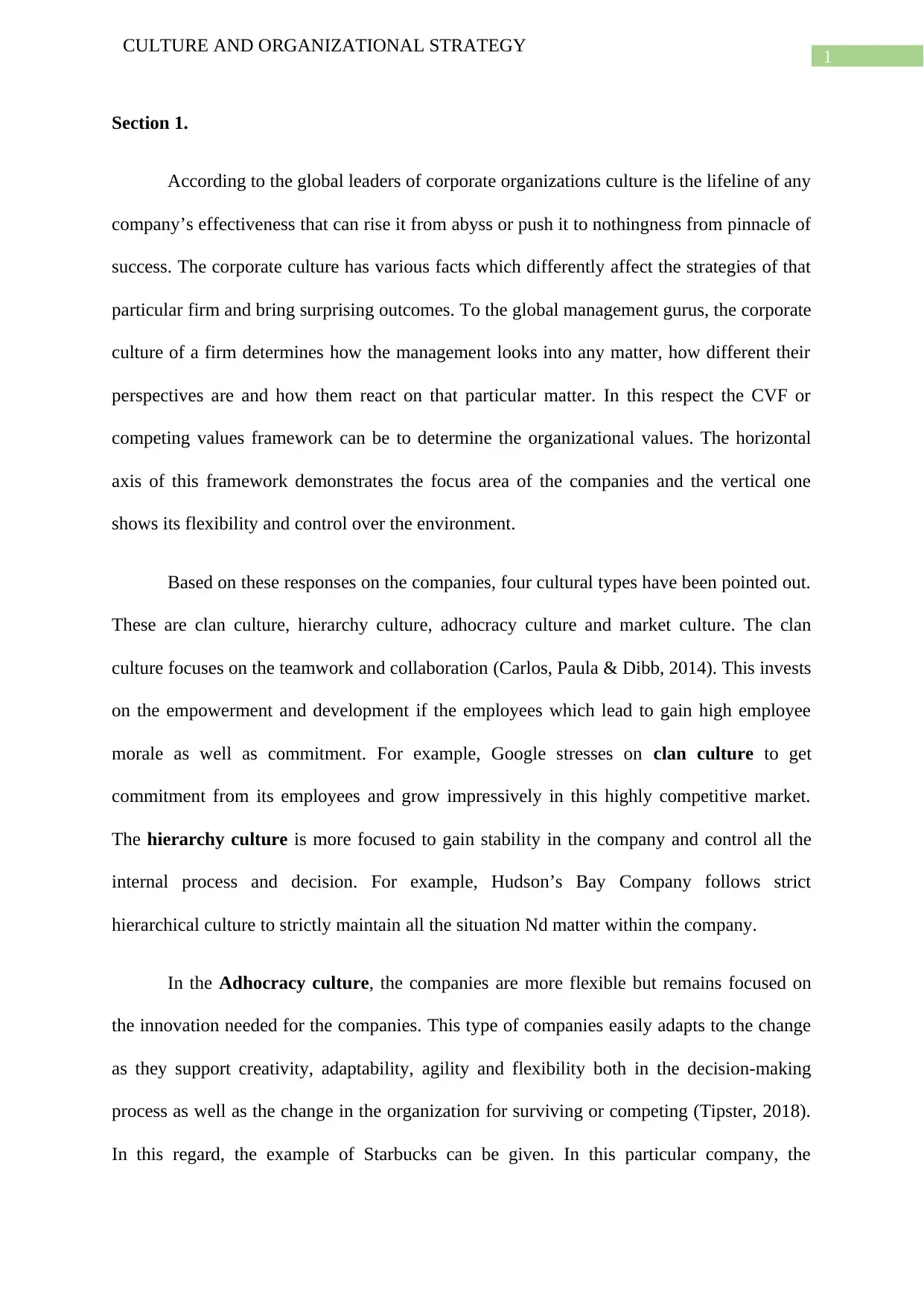
1
CULTURE AND ORGANIZATIONAL STRATEGY
Section 1.
According to the global leaders of corporate organizations culture is the lifeline of any
company’s effectiveness that can rise it from abyss or push it to nothingness from pinnacle of
success. The corporate culture has various facts which differently affect the strategies of that
particular firm and bring surprising outcomes. To the global management gurus, the corporate
culture of a firm determines how the management looks into any matter, how different their
perspectives are and how them react on that particular matter. In this respect the CVF or
competing values framework can be to determine the organizational values. The horizontal
axis of this framework demonstrates the focus area of the companies and the vertical one
shows its flexibility and control over the environment.
Based on these responses on the companies, four cultural types have been pointed out.
These are clan culture, hierarchy culture, adhocracy culture and market culture. The clan
culture focuses on the teamwork and collaboration (Carlos, Paula & Dibb, 2014). This invests
on the empowerment and development if the employees which lead to gain high employee
morale as well as commitment. For example, Google stresses on clan culture to get
commitment from its employees and grow impressively in this highly competitive market.
The hierarchy culture is more focused to gain stability in the company and control all the
internal process and decision. For example, Hudson’s Bay Company follows strict
hierarchical culture to strictly maintain all the situation Nd matter within the company.
In the Adhocracy culture, the companies are more flexible but remains focused on
the innovation needed for the companies. This type of companies easily adapts to the change
as they support creativity, adaptability, agility and flexibility both in the decision-making
process as well as the change in the organization for surviving or competing (Tipster, 2018).
In this regard, the example of Starbucks can be given. In this particular company, the
CULTURE AND ORGANIZATIONAL STRATEGY
Section 1.
According to the global leaders of corporate organizations culture is the lifeline of any
company’s effectiveness that can rise it from abyss or push it to nothingness from pinnacle of
success. The corporate culture has various facts which differently affect the strategies of that
particular firm and bring surprising outcomes. To the global management gurus, the corporate
culture of a firm determines how the management looks into any matter, how different their
perspectives are and how them react on that particular matter. In this respect the CVF or
competing values framework can be to determine the organizational values. The horizontal
axis of this framework demonstrates the focus area of the companies and the vertical one
shows its flexibility and control over the environment.
Based on these responses on the companies, four cultural types have been pointed out.
These are clan culture, hierarchy culture, adhocracy culture and market culture. The clan
culture focuses on the teamwork and collaboration (Carlos, Paula & Dibb, 2014). This invests
on the empowerment and development if the employees which lead to gain high employee
morale as well as commitment. For example, Google stresses on clan culture to get
commitment from its employees and grow impressively in this highly competitive market.
The hierarchy culture is more focused to gain stability in the company and control all the
internal process and decision. For example, Hudson’s Bay Company follows strict
hierarchical culture to strictly maintain all the situation Nd matter within the company.
In the Adhocracy culture, the companies are more flexible but remains focused on
the innovation needed for the companies. This type of companies easily adapts to the change
as they support creativity, adaptability, agility and flexibility both in the decision-making
process as well as the change in the organization for surviving or competing (Tipster, 2018).
In this regard, the example of Starbucks can be given. In this particular company, the
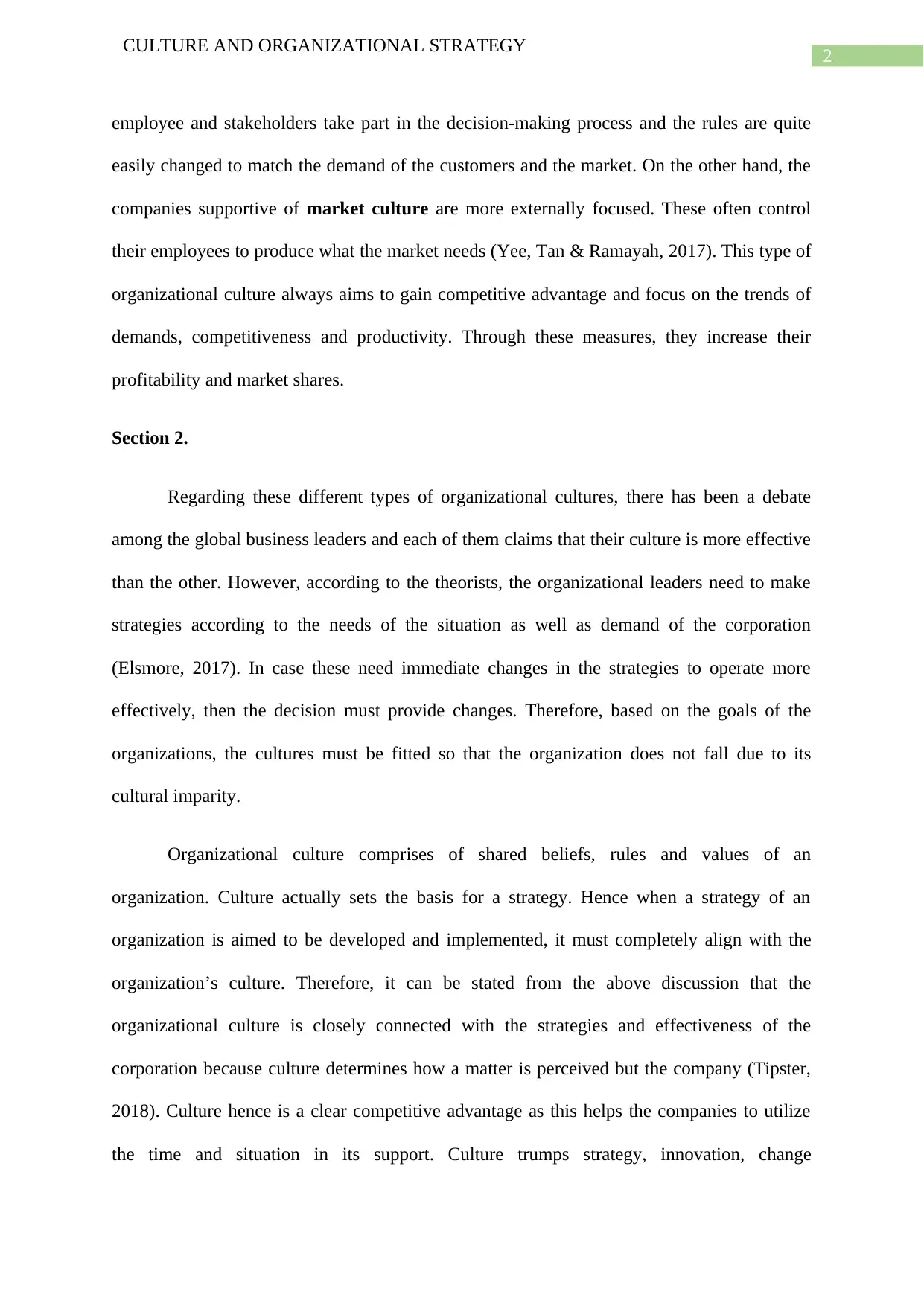
2
CULTURE AND ORGANIZATIONAL STRATEGY
employee and stakeholders take part in the decision-making process and the rules are quite
easily changed to match the demand of the customers and the market. On the other hand, the
companies supportive of market culture are more externally focused. These often control
their employees to produce what the market needs (Yee, Tan & Ramayah, 2017). This type of
organizational culture always aims to gain competitive advantage and focus on the trends of
demands, competitiveness and productivity. Through these measures, they increase their
profitability and market shares.
Section 2.
Regarding these different types of organizational cultures, there has been a debate
among the global business leaders and each of them claims that their culture is more effective
than the other. However, according to the theorists, the organizational leaders need to make
strategies according to the needs of the situation as well as demand of the corporation
(Elsmore, 2017). In case these need immediate changes in the strategies to operate more
effectively, then the decision must provide changes. Therefore, based on the goals of the
organizations, the cultures must be fitted so that the organization does not fall due to its
cultural imparity.
Organizational culture comprises of shared beliefs, rules and values of an
organization. Culture actually sets the basis for a strategy. Hence when a strategy of an
organization is aimed to be developed and implemented, it must completely align with the
organization’s culture. Therefore, it can be stated from the above discussion that the
organizational culture is closely connected with the strategies and effectiveness of the
corporation because culture determines how a matter is perceived but the company (Tipster,
2018). Culture hence is a clear competitive advantage as this helps the companies to utilize
the time and situation in its support. Culture trumps strategy, innovation, change
CULTURE AND ORGANIZATIONAL STRATEGY
employee and stakeholders take part in the decision-making process and the rules are quite
easily changed to match the demand of the customers and the market. On the other hand, the
companies supportive of market culture are more externally focused. These often control
their employees to produce what the market needs (Yee, Tan & Ramayah, 2017). This type of
organizational culture always aims to gain competitive advantage and focus on the trends of
demands, competitiveness and productivity. Through these measures, they increase their
profitability and market shares.
Section 2.
Regarding these different types of organizational cultures, there has been a debate
among the global business leaders and each of them claims that their culture is more effective
than the other. However, according to the theorists, the organizational leaders need to make
strategies according to the needs of the situation as well as demand of the corporation
(Elsmore, 2017). In case these need immediate changes in the strategies to operate more
effectively, then the decision must provide changes. Therefore, based on the goals of the
organizations, the cultures must be fitted so that the organization does not fall due to its
cultural imparity.
Organizational culture comprises of shared beliefs, rules and values of an
organization. Culture actually sets the basis for a strategy. Hence when a strategy of an
organization is aimed to be developed and implemented, it must completely align with the
organization’s culture. Therefore, it can be stated from the above discussion that the
organizational culture is closely connected with the strategies and effectiveness of the
corporation because culture determines how a matter is perceived but the company (Tipster,
2018). Culture hence is a clear competitive advantage as this helps the companies to utilize
the time and situation in its support. Culture trumps strategy, innovation, change
⊘ This is a preview!⊘
Do you want full access?
Subscribe today to unlock all pages.

Trusted by 1+ million students worldwide
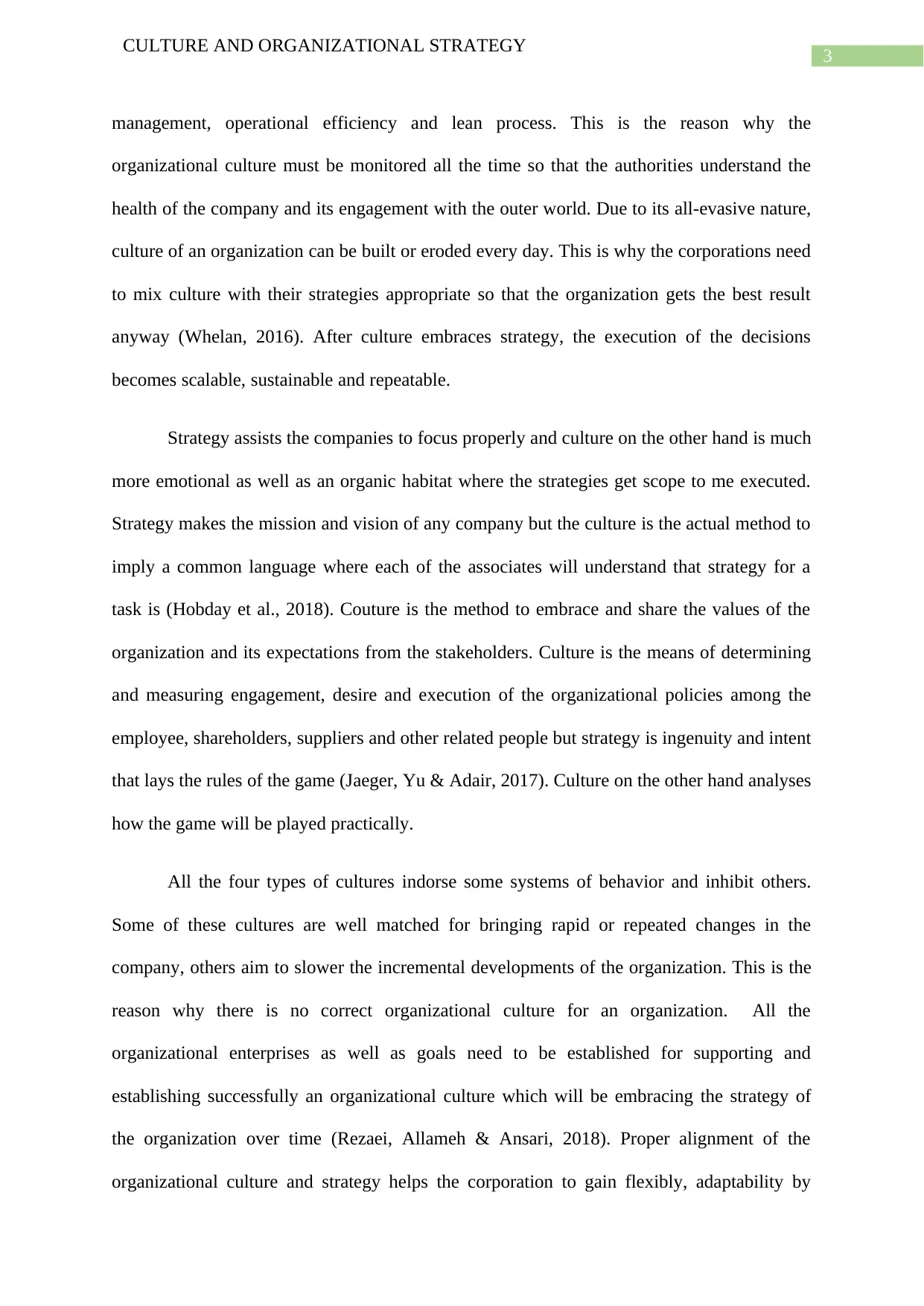
3
CULTURE AND ORGANIZATIONAL STRATEGY
management, operational efficiency and lean process. This is the reason why the
organizational culture must be monitored all the time so that the authorities understand the
health of the company and its engagement with the outer world. Due to its all-evasive nature,
culture of an organization can be built or eroded every day. This is why the corporations need
to mix culture with their strategies appropriate so that the organization gets the best result
anyway (Whelan, 2016). After culture embraces strategy, the execution of the decisions
becomes scalable, sustainable and repeatable.
Strategy assists the companies to focus properly and culture on the other hand is much
more emotional as well as an organic habitat where the strategies get scope to me executed.
Strategy makes the mission and vision of any company but the culture is the actual method to
imply a common language where each of the associates will understand that strategy for a
task is (Hobday et al., 2018). Couture is the method to embrace and share the values of the
organization and its expectations from the stakeholders. Culture is the means of determining
and measuring engagement, desire and execution of the organizational policies among the
employee, shareholders, suppliers and other related people but strategy is ingenuity and intent
that lays the rules of the game (Jaeger, Yu & Adair, 2017). Culture on the other hand analyses
how the game will be played practically.
All the four types of cultures indorse some systems of behavior and inhibit others.
Some of these cultures are well matched for bringing rapid or repeated changes in the
company, others aim to slower the incremental developments of the organization. This is the
reason why there is no correct organizational culture for an organization. All the
organizational enterprises as well as goals need to be established for supporting and
establishing successfully an organizational culture which will be embracing the strategy of
the organization over time (Rezaei, Allameh & Ansari, 2018). Proper alignment of the
organizational culture and strategy helps the corporation to gain flexibly, adaptability by
CULTURE AND ORGANIZATIONAL STRATEGY
management, operational efficiency and lean process. This is the reason why the
organizational culture must be monitored all the time so that the authorities understand the
health of the company and its engagement with the outer world. Due to its all-evasive nature,
culture of an organization can be built or eroded every day. This is why the corporations need
to mix culture with their strategies appropriate so that the organization gets the best result
anyway (Whelan, 2016). After culture embraces strategy, the execution of the decisions
becomes scalable, sustainable and repeatable.
Strategy assists the companies to focus properly and culture on the other hand is much
more emotional as well as an organic habitat where the strategies get scope to me executed.
Strategy makes the mission and vision of any company but the culture is the actual method to
imply a common language where each of the associates will understand that strategy for a
task is (Hobday et al., 2018). Couture is the method to embrace and share the values of the
organization and its expectations from the stakeholders. Culture is the means of determining
and measuring engagement, desire and execution of the organizational policies among the
employee, shareholders, suppliers and other related people but strategy is ingenuity and intent
that lays the rules of the game (Jaeger, Yu & Adair, 2017). Culture on the other hand analyses
how the game will be played practically.
All the four types of cultures indorse some systems of behavior and inhibit others.
Some of these cultures are well matched for bringing rapid or repeated changes in the
company, others aim to slower the incremental developments of the organization. This is the
reason why there is no correct organizational culture for an organization. All the
organizational enterprises as well as goals need to be established for supporting and
establishing successfully an organizational culture which will be embracing the strategy of
the organization over time (Rezaei, Allameh & Ansari, 2018). Proper alignment of the
organizational culture and strategy helps the corporation to gain flexibly, adaptability by
Paraphrase This Document
Need a fresh take? Get an instant paraphrase of this document with our AI Paraphraser
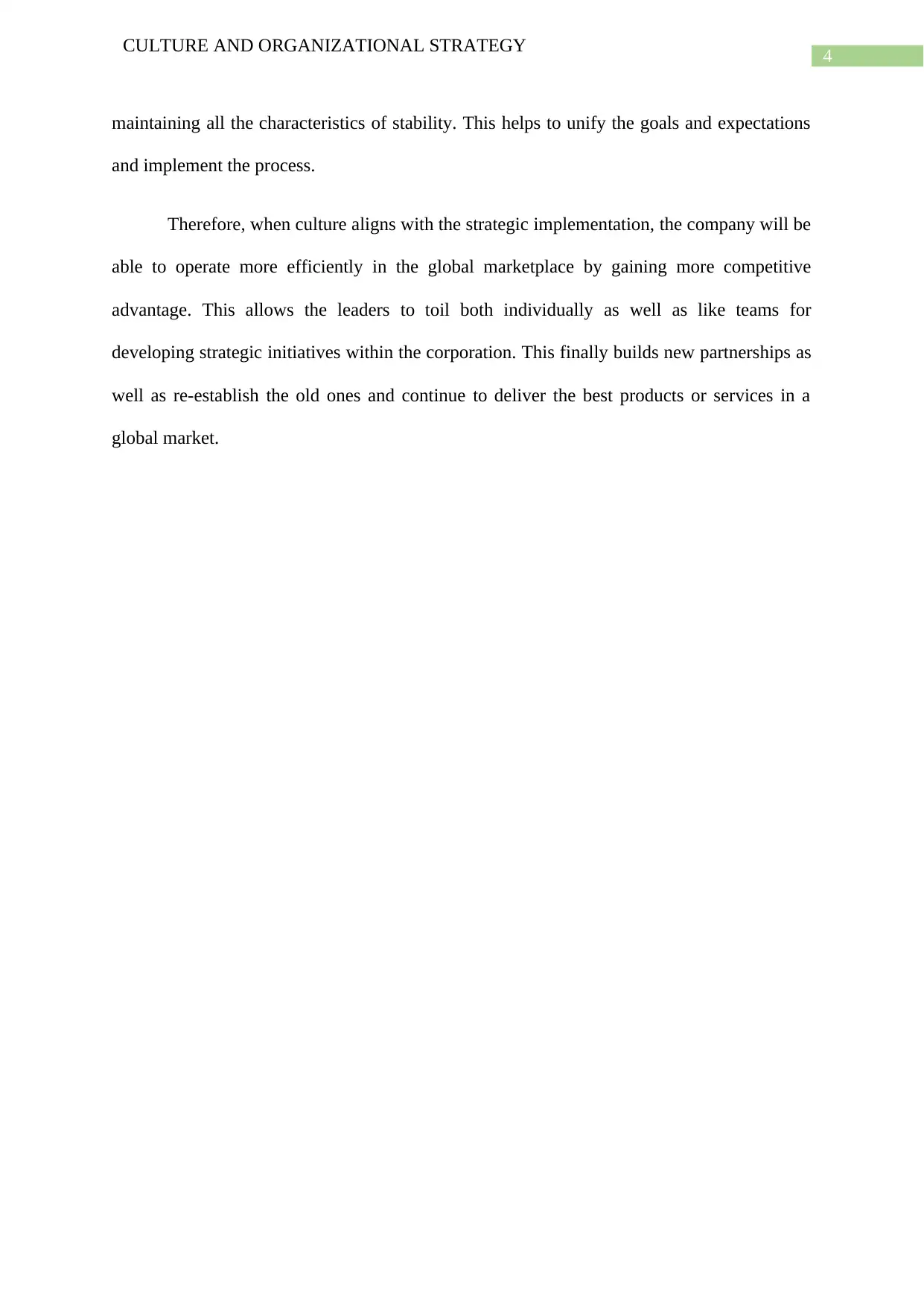
4
CULTURE AND ORGANIZATIONAL STRATEGY
maintaining all the characteristics of stability. This helps to unify the goals and expectations
and implement the process.
Therefore, when culture aligns with the strategic implementation, the company will be
able to operate more efficiently in the global marketplace by gaining more competitive
advantage. This allows the leaders to toil both individually as well as like teams for
developing strategic initiatives within the corporation. This finally builds new partnerships as
well as re-establish the old ones and continue to deliver the best products or services in a
global market.
CULTURE AND ORGANIZATIONAL STRATEGY
maintaining all the characteristics of stability. This helps to unify the goals and expectations
and implement the process.
Therefore, when culture aligns with the strategic implementation, the company will be
able to operate more efficiently in the global marketplace by gaining more competitive
advantage. This allows the leaders to toil both individually as well as like teams for
developing strategic initiatives within the corporation. This finally builds new partnerships as
well as re-establish the old ones and continue to deliver the best products or services in a
global market.
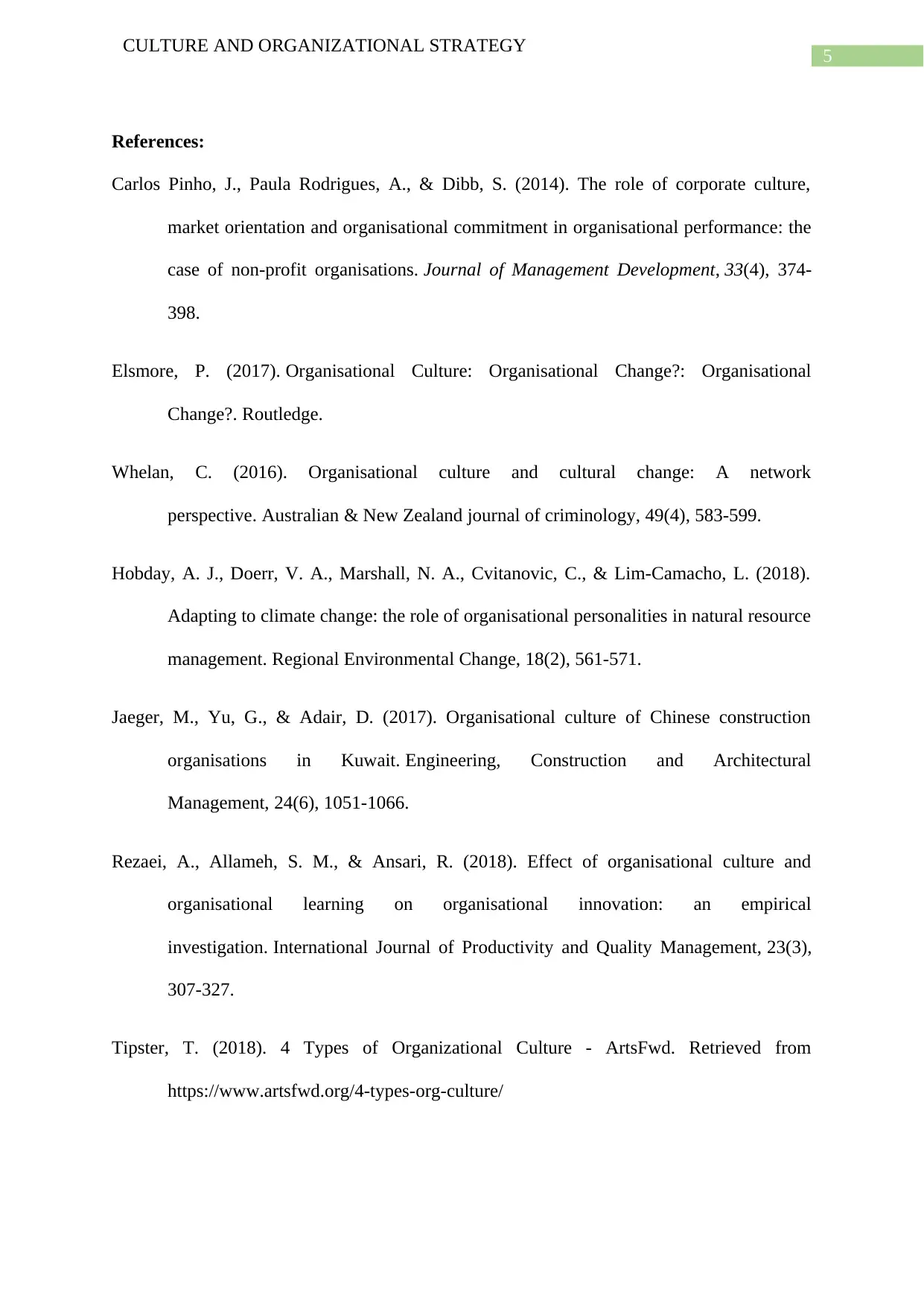
5
CULTURE AND ORGANIZATIONAL STRATEGY
References:
Carlos Pinho, J., Paula Rodrigues, A., & Dibb, S. (2014). The role of corporate culture,
market orientation and organisational commitment in organisational performance: the
case of non-profit organisations. Journal of Management Development, 33(4), 374-
398.
Elsmore, P. (2017). Organisational Culture: Organisational Change?: Organisational
Change?. Routledge.
Whelan, C. (2016). Organisational culture and cultural change: A network
perspective. Australian & New Zealand journal of criminology, 49(4), 583-599.
Hobday, A. J., Doerr, V. A., Marshall, N. A., Cvitanovic, C., & Lim-Camacho, L. (2018).
Adapting to climate change: the role of organisational personalities in natural resource
management. Regional Environmental Change, 18(2), 561-571.
Jaeger, M., Yu, G., & Adair, D. (2017). Organisational culture of Chinese construction
organisations in Kuwait. Engineering, Construction and Architectural
Management, 24(6), 1051-1066.
Rezaei, A., Allameh, S. M., & Ansari, R. (2018). Effect of organisational culture and
organisational learning on organisational innovation: an empirical
investigation. International Journal of Productivity and Quality Management, 23(3),
307-327.
Tipster, T. (2018). 4 Types of Organizational Culture - ArtsFwd. Retrieved from
https://www.artsfwd.org/4-types-org-culture/
CULTURE AND ORGANIZATIONAL STRATEGY
References:
Carlos Pinho, J., Paula Rodrigues, A., & Dibb, S. (2014). The role of corporate culture,
market orientation and organisational commitment in organisational performance: the
case of non-profit organisations. Journal of Management Development, 33(4), 374-
398.
Elsmore, P. (2017). Organisational Culture: Organisational Change?: Organisational
Change?. Routledge.
Whelan, C. (2016). Organisational culture and cultural change: A network
perspective. Australian & New Zealand journal of criminology, 49(4), 583-599.
Hobday, A. J., Doerr, V. A., Marshall, N. A., Cvitanovic, C., & Lim-Camacho, L. (2018).
Adapting to climate change: the role of organisational personalities in natural resource
management. Regional Environmental Change, 18(2), 561-571.
Jaeger, M., Yu, G., & Adair, D. (2017). Organisational culture of Chinese construction
organisations in Kuwait. Engineering, Construction and Architectural
Management, 24(6), 1051-1066.
Rezaei, A., Allameh, S. M., & Ansari, R. (2018). Effect of organisational culture and
organisational learning on organisational innovation: an empirical
investigation. International Journal of Productivity and Quality Management, 23(3),
307-327.
Tipster, T. (2018). 4 Types of Organizational Culture - ArtsFwd. Retrieved from
https://www.artsfwd.org/4-types-org-culture/
⊘ This is a preview!⊘
Do you want full access?
Subscribe today to unlock all pages.

Trusted by 1+ million students worldwide
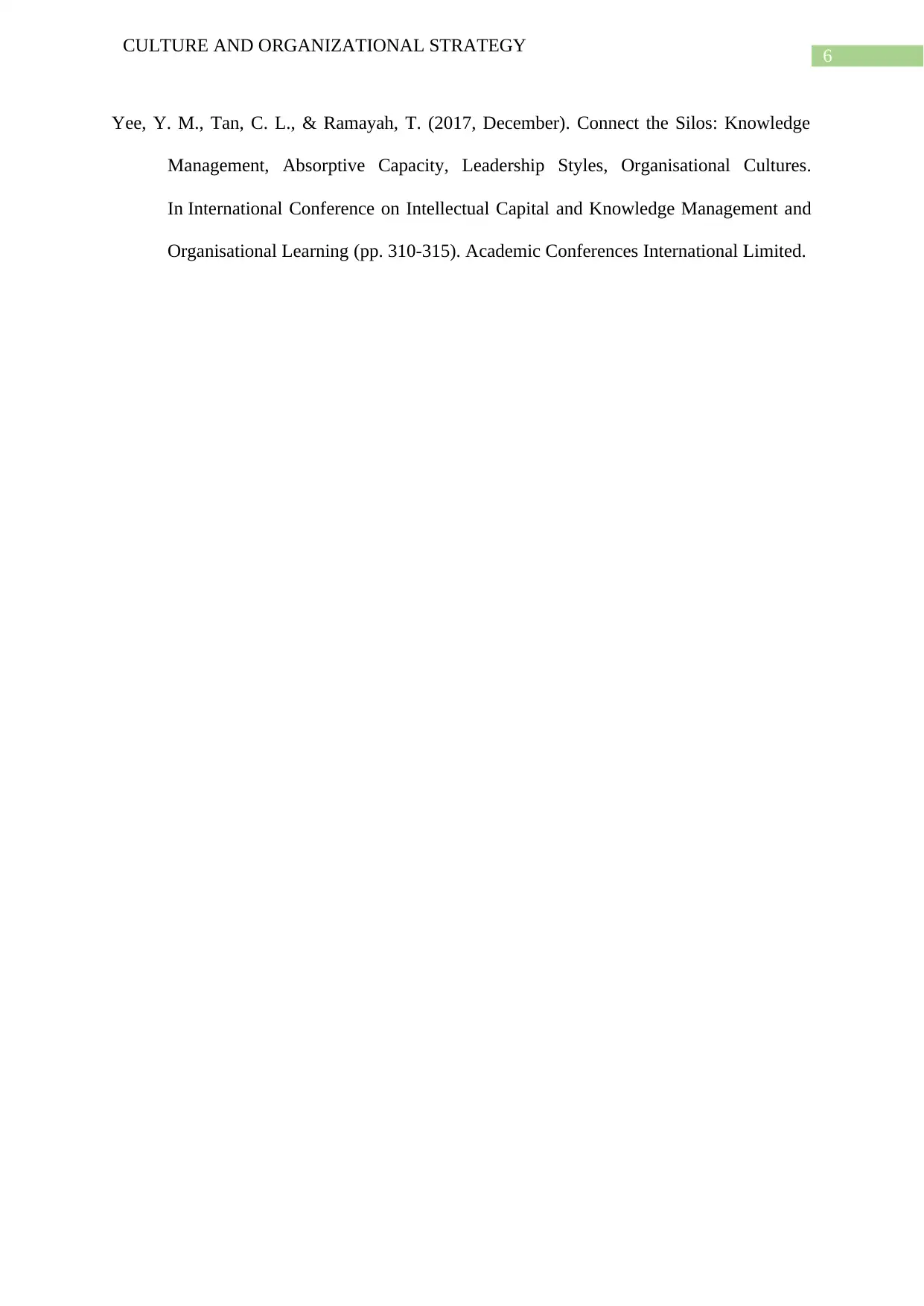
6
CULTURE AND ORGANIZATIONAL STRATEGY
Yee, Y. M., Tan, C. L., & Ramayah, T. (2017, December). Connect the Silos: Knowledge
Management, Absorptive Capacity, Leadership Styles, Organisational Cultures.
In International Conference on Intellectual Capital and Knowledge Management and
Organisational Learning (pp. 310-315). Academic Conferences International Limited.
CULTURE AND ORGANIZATIONAL STRATEGY
Yee, Y. M., Tan, C. L., & Ramayah, T. (2017, December). Connect the Silos: Knowledge
Management, Absorptive Capacity, Leadership Styles, Organisational Cultures.
In International Conference on Intellectual Capital and Knowledge Management and
Organisational Learning (pp. 310-315). Academic Conferences International Limited.
1 out of 7
Related Documents
Your All-in-One AI-Powered Toolkit for Academic Success.
+13062052269
info@desklib.com
Available 24*7 on WhatsApp / Email
![[object Object]](/_next/static/media/star-bottom.7253800d.svg)
Unlock your academic potential
Copyright © 2020–2025 A2Z Services. All Rights Reserved. Developed and managed by ZUCOL.




